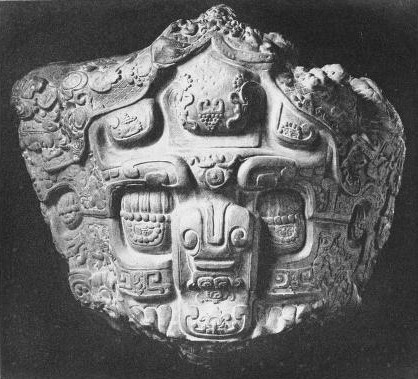
THE MYTHOLOGYOF ALL RACES
IN THIRTEEN VOLUMES
LOUIS HERBERT GRAY, A.M., PH.D., Editor
GEORGE FOOT MOORE, A.M., D.D., LL.D., Consulting Editor
LATIN-AMERICAN
BY
HARTLEY BURR ALEXANDER, PH.D.
PROFESSOR OF PHILOSOPHY
UNIVERSITY OF NEBRASKA
VOLUME XI
BOSTON
MARSHALL JONES COMPANY
M DCCCC XX

Top face of the monolith known as the "Dragon"or the "Great Turtle" of Quirigua. This is one ofthe group of stelae and "altars" which mark theceremonial courts of this vanished Maya city (seePlate XXIII); and is perhaps the master-worknot only of Mayan, but of aboriginal American art.The top of the stone here figured shows a highlyconventionalized daemon or dragon mask, surroundedby a complication of ornament. Thenorth and south (here lower and upper) faces of themonument contain representations of divinities; onthe south face is a mask of the "god with the ornamentednose" (possibly Ahpuch, the death god),and on the north, seated within the open mouthof the Dragon, the teeth of whose upper jaw appearon the top face of the monument, is carved a serene,Buddha-like divinity shown in Plate XXV. TheMaya date corresponding, probably, to 525 a. d.appears in a glyphic inscription on the shoulder ofthe Dragon. The monument is fully described byW. H. Holmes, Art and Archaeology, Vol. IV, No. 6.
TO
ALICE CUNNINGHAM FLETCHER
IN APPRECIATION OF HER INTERPRETATIONS OFAMERICAN INDIAN LIFE AND LORE
AUTHOR'S PREFACE
In aim and plan the present volume is made to accord asnearly as may be with the earlier-written volume on themythology of the North American Indians. Owing to divergenceof the materials, some deviations of method have beennecessary, but in their main lines the two books correspondin form as they are continuous in matter. In each case theauthor has aimed primarily at a descriptive treatment, followingregional divisions, and directed to essential conceptionsrather than to exhaustive classification; and in each case ithas been, not the specialist in the field, but the scholar with kindredinterests and the reader of broadly humane tastes whomthe author has had before him.
The difficulties besetting the composition of both books havebeen analogous, growing chiefly from the vast diversities of thesources of material; but these difficulties are decidedly greaterfor the Latin-American field. The matter of spelling is one ofthe more immediate. In general, the author has endeavouredto adhere to such of the rules given in Note 1 of Mythology ofAll Races, Vol. X (pp. 267-68), as may be applicable, seekingthe simplest